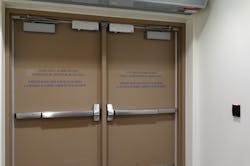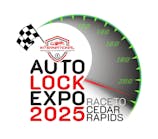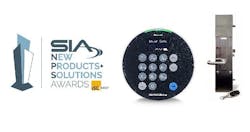As a door security-solutions training specialist, I teach locksmiths, architects and systems integrators about products and specifying door hardware to installation techniques, codes and beyond.
Many questions come up during classes and arrive in my inbox about egress, specialty doors and their related codes. Controlled egress, however, is among the most frequent topics I’m asked about.
When I present on the subject, I reference the International Building Code’s IBC 2015, because it’s the most widely adopted. Controlled egress is a separate discipline within the code and applies only to occupancies specified in Institutional Group I-1 or I-2. I-1 refers to institutional assisted living, and I-2 relates to nursing homes and hospitals.
Where, What & Why
Controlled egress is used mainly on egress doors where the security and clinical requirements of patients who receive care require their containment or restraint. In hospitals, that could be a behavioral-health area, dementia unit, infant-care wing, memory-care unit, maternity wing or emergency department.
Controlled-egress doors are used primarily at the main entry or egress point of a unit and aren’t used for patient rooms. Unless there’s an exception, there can be only one controlled-egress door in a path of egress before you reach an exit.
Controlled-egress doors use “infinite” locks, primarily maglocks, on the egress side that can be unlocked only by an authorized staff member who uses a card, badge or mobile device that triggers the electronic access control (EAC) card reader for the lock. No motion sensor, emergency push-button or anything else is allowed on the wall except the EAC reader.
Some jurisdictions don’t allow the use of maglocks, which typically means you can’t use controlled egress in these locations. Be sure to check your state and local codes carefully, or check with the local authority having jurisdiction (AHJ), because they can override national codes.
Controlled egress is necessary in certain institutional settings. In the case of behavioral health, the clinical requirements of patients require staff to look after them and their safety and to ensure the patients remain within the unit. Slipping out through an opening uninhibited could be dangerous to them and others. The same concern for patient safety applies to those who might try to wander out of a dementia unit or a memory-care facility.
For infant patient wings, unfortunately, abductions still happen more often than anyone would like to think by people involved in custody disputes as well as complete strangers. The objective is to protect the child, which necessitates the use of controlled egress.
Although some mechanical controlled-egress door locks still might exist in some behavioral-health environments, EAC and maglocks have replaced most older hardware and are the norm. In either case (mechanical or electronic), authorized clinical staff members must carry the specific credential or key while on duty to unlock the controlled-egress door and allow passage through these required protected openings.
One more note: In behavioral-health and infant-protection units, controlled-egress doors aren’t required to be tied into a fire-alarm system, because clinical staff stays with these patients to ensure they’re moved to safe refuge. However, controlled-egress doors in emergency departments, dementia units and memory-care wings are required to be tied in so the maglocks automatically release when there’s actuation of the sprinkler or smoke-detection system.
Controlled vs. Delayed
Codes for delayed-egress doors in healthcare, business, retail and other settings also require integration with fire-protection systems. However, the main distinction between controlled and delayed egress is that under normal operating conditions, delayed-egress systems allow passage only after a specified period — 15 or 30 seconds, depending on what the AHJ approves. An audible alarm sounds in the vicinity of the door to discourage someone who might have tried to exit through a delayed door or who might be trying to sneak out with something valuable.
Depending on the area within a hospital, assisted-living facility or nursing home, you could find a blend of egress solutions depending on what an AHJ allows. That’s why it’s so important to understand codes that detail what can and can’t go into an opening in various types of facilities.
Places where delayed or controlled egress is not allowed include venues, such as nightclubs, restaurants and arenas, where large numbers of people assemble and have to be able to exit quickly and without hindrance if there’s an emergency.
Delayed egress has been in the IBC since 1981, but controlled egress didn’t come online with IBC until 2009. However, it became part of the National Fire Protection Association’s 101 Life Safety code in the 2006 edition. Both have similar requirements. Of the four special locking arrangements that codes identify, controlled egress is considered the most restricted because of its limited use.
Although controlled-egress codes haven’t changed much, some of the technology has, so it pays to stay up on changes. That’s why it’s important to note new releases and take advantage of training to keep sharp about codes.
Katie Flower, AOC, CFDAI, is a training specialist at ASSA ABLOY Academy.
Katie Flower, AOC, CFDAI
Katie Flower, AOC, CFDAI, is a training specialist at ASSA ABLOY Academy.







